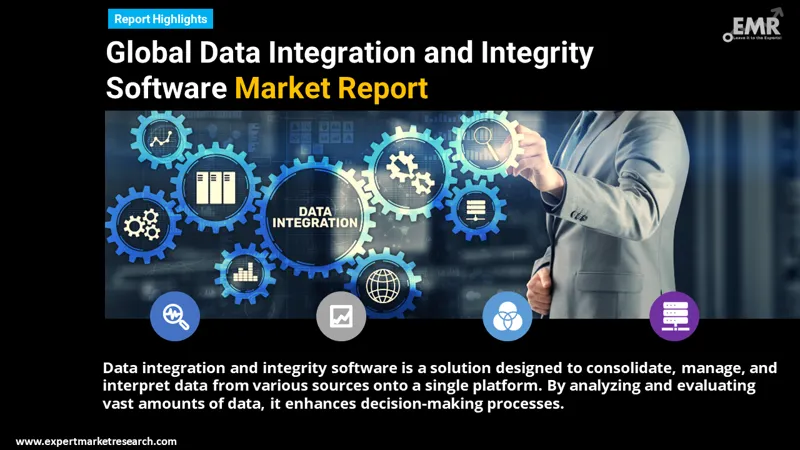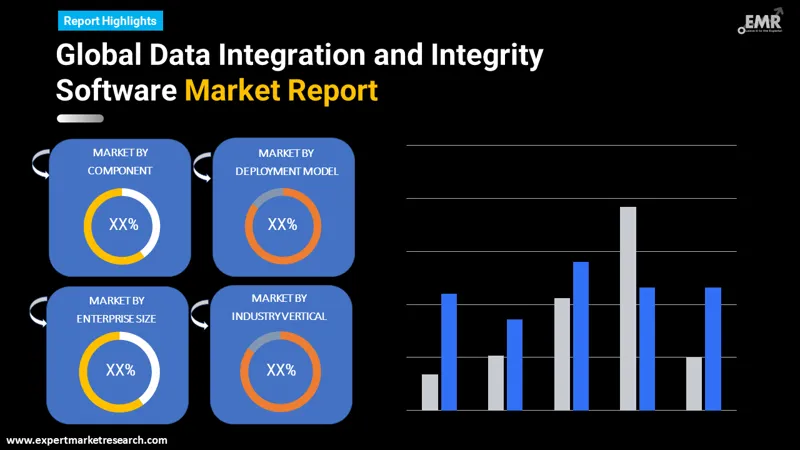
Consumer Insights
Uncover trends and behaviors shaping consumer choices today
Procurement Insights
Optimize your sourcing strategy with key market data
Industry Stats
Stay ahead with the latest trends and market analysis.
The global data integration and integrity software market attained a value of about USD 15.85 Billion in 2025. The market is further expected to grow in the forecast period of 2026-2035 at a CAGR of 12.67% to reach nearly USD 52.25 Billion by 2035.
Base Year
Historical Period
Forecast Period
Compound Annual Growth Rate
12.67%
Value in USD Billion
2026-2035
*this image is indicative*
| Data Integration and Integrity Software Market Report Summary | Description | Value |
| Base Year | USD Billion | 2025 |
| Historical Period | USD Billion | 2019-2025 |
| Forecast Period | USD Billion | 2026-2035 |
| Market Size 2025 | USD Billion | 15.85 |
| Market Size 2035 | USD Billion | 52.25 |
| CAGR 2019-2025 | Percentage | XX% |
| CAGR 2026-2035 | Percentage | 12.67% |
| CAGR 2026-2035 - Market by Region | Asia Pacific | 8.2% |
| CAGR 2026-2035 - Market by Country | India | 9.4% |
| CAGR 2026-2035 - Market by Country | UK | 9.1% |
| CAGR 2026-2035 - Market by Enterprise Size | Small and Medium Enterprises | 13.9% |
| CAGR 2026-2035 - Market by Industry Vertical | IT and Telecommunication | 15.4% |
| Market Share by Country 2025 | Australia | 3.1% |
The increasing deployment of data integration and integrity software for the reconciliation and assessment of data in the healthcare sector is propelling the market growth. As medical data is crucial for optimal healthcare in the industry, data integration and integrity software are increasingly deployed to extract and eliminate data effectively while bolstering security, which is propelling the industry growth. Furthermore, the extensive amount of data generated by wearables is surging the demand for effective data reconciliation while adhering to data privacy and security regulations. This, in turn, is increasing the demand for data integration and integrity software, hence invigorating the growth of the industry.

Read more about this report - REQUEST FREE SAMPLE COPY IN PDF
The increasing use of technologies to provide healthcare services like retail care, telehealth, e-pharmacy, care-on-point, among others, is increasing the generation of data, hence providing further impetus to the market growth. Moreover, the growing deployment of data integration and integrity software to prevent medical errors and comply with regulatory standards is predicted to bolster the industry growth in upcoming years.

Read more about this report - REQUEST FREE SAMPLE COPY IN PDF
Data integration and integrity software is a solution that is used to combine, manage, and comprehend data from multiple sources to a platform. It bolsters decision-making processes by analysing and assessing a huge amount of data. The use of data integration and integrity software reduces operational costs, bolsters operational efficiency, and enhance data quality.
Market Breakup by Component
Market Breakup by Deployment Model
Market Breakup by Enterprise Size
Market Breakup by Industry Vertical
Market Breakup by Region
| CAGR 2026-2035 - Market by | Enterprise Size |
| Small and Medium Enterprises | 13.9% |
| Large Enterprises | XX% |
| CAGR 2026-2035 - Market by | Industry Vertical |
| IT and Telecommunication | 15.4% |
| BFSI | 13.1% |
| Manufacturing | XX% |
| Healthcare | XX% |
| Retail | XX% |
| Others | XX% |
| CAGR 2026-2035 - Market by | Region |
| Asia Pacific | 8.2% |
| Europe | 7.6% |
| North America | XX% |
| Latin America | XX% |
| Middle East and Africa | XX% |
| CAGR 2026-2035 - Market by | Country |
| India | 9.4% |
| UK | 9.1% |
| China | 7.9% |
| Germany | 7.3% |
| France | 6.9% |
| USA | XX% |
| Canada | XX% |
| Italy | 6.2% |
| Japan | XX% |
| Australia | XX% |
| Saudi Arabia | XX% |
| Brazil | XX% |
| Mexico | XX% |
The increasing adoption of cloud-based data integration and integrity software to enable the consolidation of an extensive amount of data while providing valuable insights is propelling the market growth. As the use of cloud-based data integration and integrity software boosts operational efficiency and streamlines workflow, their demand is significantly surging. The increasing complexity of multi-cloud projects is surging the demand for cloud-based data integration and integrity software to organise and analyse data and meet regulatory compliances, which is driving the growth of the market.
| 2025 Market Share by | Country |
| Australia | 3.1% |
| USA | XX% |
| Canada | XX% |
The integration of the latest technologies like artificial intelligence (AI) and machine learning in data integration and integrity software is expected to bolster the market growth. Such technologies are leading to the automation of data collection and analysis while bolstering decision-making processes. In addition, the deployment of machine learning and artificial intelligence (AI) ensure the effectiveness of data pipelines by simplifying the creation of integration. As such technologies eliminate the requirement for human intervention, they bolster the overall cost-effectiveness of data integration and integrity software. Hence, the growing exploitation of artificial intelligence (AI) and the increasing deployment of the latest technologies in data integration and integrity software are anticipated to bolster the market growth.
The report presents a detailed analysis of the following key players in the global data integration and integrity software market, looking into their capacity, market shares, and latest developments like capacity expansions, plant turnarounds, and mergers and acquisitions:
The comprehensive report looks into the macro and micro aspects of the industry. The EMR report gives an in-depth insight into the market by providing a SWOT analysis as well as an analysis of Porter’s Five Forces model.




*While we strive to always give you current and accurate information, the numbers depicted on the website are indicative and may differ from the actual numbers in the main report. At Expert Market Research, we aim to bring you the latest insights and trends in the market. Using our analyses and forecasts, stakeholders can understand the market dynamics, navigate challenges, and capitalize on opportunities to make data-driven strategic decisions.*
Get in touch with us for a customized solution tailored to your unique requirements and save upto 35%!
In 2025, the global data integration and integrity software market attained a value of nearly USD 15.85 Billion.
The market is projected to grow at a CAGR of 12.67% between 2026 and 2035.
The market is estimated to witness a healthy growth in the forecast period of 2026-2035 to reach about USD 52.25 Billion by 2035.
The major market drivers include increasing deployment of data integration and integrity software in the healthcare sector and the extensive data generation by wearables.
The key trends guiding the market include the growing adoption of cloud-based data integration and integrity software, the increasing complexity of multi-cloud projects, and the integration of artificial intelligence (AI) and machine learning in data integration and integrity software.
The major regions in the market are North America, Latin America, the Middle East and Africa, Europe, and the Asia Pacific.
The major components of data integration and integrity software in the market are tools (solutions) and services.
The different deployment models of data integration and integrity software are on-premises and on-demand.
The several enterprise sizes considered in the market report are large enterprise and small and medium enterprise.
The significant industry verticals of data integration and integrity software are IT and telecommunication, BFSI, manufacturing, healthcare, retail, and aerospace and defence, among others.
The major players in the market are Oracle Corporation, Informatica LLC, IBM Corporation, SAP SE, Talend Inc., Cisco Systems, Inc., SAS Institute Inc., TIBCO Software Inc. (Information Builders), Microsoft Corporation, and QlikTech International AB (Attunity), among others.
Explore our key highlights of the report and gain a concise overview of key findings, trends, and actionable insights that will empower your strategic decisions.
| REPORT FEATURES | DETAILS |
| Base Year | 2025 |
| Historical Period | 2019-2025 |
| Forecast Period | 2026-2035 |
| Scope of the Report |
Historical and Forecast Trends, Industry Drivers and Constraints, Historical and Forecast Market Analysis by Segment:
|
| Breakup by Component |
|
| Breakup by Deployment Model |
|
| Breakup by Enterprise Size |
|
| Breakup by Industry Vertical |
|
| Breakup by Region |
|
| Market Dynamics |
|
| Competitive Landscape |
|
| Companies Covered |
|
| Report Price and Purchase Option | Explore our purchase options that are best suited to your resources and industry needs. |
| Delivery Format | Delivered as an attached PDF and Excel through email, with an option of receiving an editable PPT, according to the purchase option. |
Datasheet
One User
USD 2,499
USD 2,249
tax inclusive*
Single User License
One User
USD 3,999
USD 3,599
tax inclusive*
Five User License
Five User
USD 4,999
USD 4,249
tax inclusive*
Corporate License
Unlimited Users
USD 5,999
USD 5,099
tax inclusive*
*Please note that the prices mentioned below are starting prices for each bundle type. Kindly contact our team for further details.*
Flash Bundle
Small Business Bundle
Growth Bundle
Enterprise Bundle
*Please note that the prices mentioned below are starting prices for each bundle type. Kindly contact our team for further details.*
Flash Bundle
Number of Reports: 3
20%
tax inclusive*
Small Business Bundle
Number of Reports: 5
25%
tax inclusive*
Growth Bundle
Number of Reports: 8
30%
tax inclusive*
Enterprise Bundle
Number of Reports: 10
35%
tax inclusive*
How To Order

Select License Type
Choose the right license for your needs and access rights.

Click on ‘Buy Now’
Add the report to your cart with one click and proceed to register.

Select Mode of Payment
Choose a payment option for a secure checkout. You will be redirected accordingly.
Gain insights to stay ahead and seize opportunities.

Get insights & trends for a competitive edge.

Track prices with detailed trend reports.

Analyse trade data for supply chain insights.

Leverage cost reports for smart savings

Enhance supply chain with partnerships.

Connect For More Information
Our expert team of analysts will offer full support and resolve any queries regarding the report, before and after the purchase.
Our expert team of analysts will offer full support and resolve any queries regarding the report, before and after the purchase.
We employ meticulous research methods, blending advanced analytics and expert insights to deliver accurate, actionable industry intelligence, staying ahead of competitors.
Our skilled analysts offer unparalleled competitive advantage with detailed insights on current and emerging markets, ensuring your strategic edge.
We offer an in-depth yet simplified presentation of industry insights and analysis to meet your specific requirements effectively.
Share